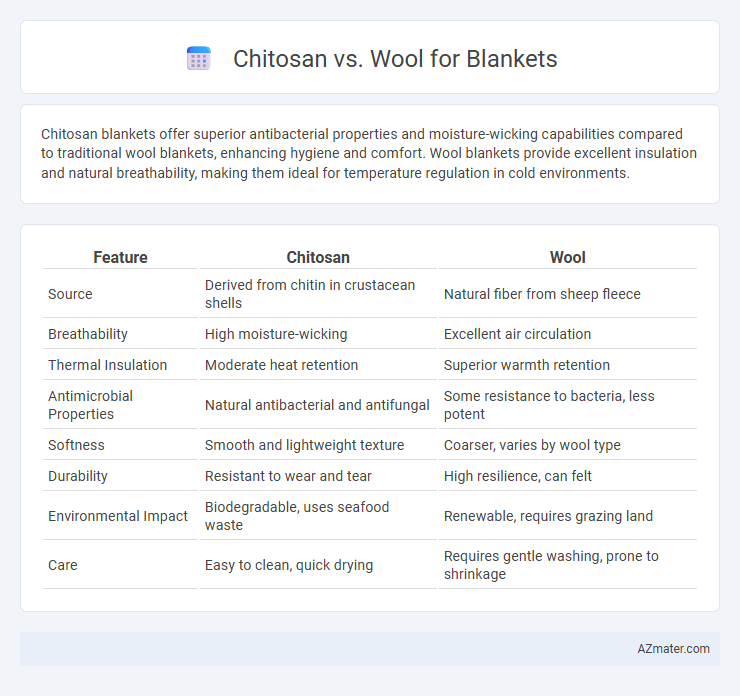Chitosan blankets offer superior antibacterial properties and moisture-wicking capabilities compared to traditional wool blankets, enhancing hygiene and comfort. Wool blankets provide excellent insulation and natural breathability, making them ideal for temperature regulation in cold environments.
Table of Comparison
| Feature | Chitosan | Wool |
|---|---|---|
| Source | Derived from chitin in crustacean shells | Natural fiber from sheep fleece |
| Breathability | High moisture-wicking | Excellent air circulation |
| Thermal Insulation | Moderate heat retention | Superior warmth retention |
| Antimicrobial Properties | Natural antibacterial and antifungal | Some resistance to bacteria, less potent |
| Softness | Smooth and lightweight texture | Coarser, varies by wool type |
| Durability | Resistant to wear and tear | High resilience, can felt |
| Environmental Impact | Biodegradable, uses seafood waste | Renewable, requires grazing land |
| Care | Easy to clean, quick drying | Requires gentle washing, prone to shrinkage |
Introduction: Chitosan and Wool as Blanket Materials
Chitosan and wool serve as distinct blanket materials, each offering unique benefits in comfort and functionality. Chitosan, derived from crustacean shells, provides antimicrobial properties and moisture-wicking capabilities that enhance hygiene and breathability. Wool, naturally sourced from sheep, excels in insulation and temperature regulation due to its innate fiber structure, making both materials popular choices for sustainable and high-performance blankets.
Origin and Sources: Chitosan vs. Wool
Chitosan is a natural biopolymer derived from chitin, primarily sourced from the exoskeletons of crustaceans such as shrimp and crabs, making it abundant and biodegradable. Wool originates from the fleece of sheep and other animals like alpacas and goats, valued for its insulating properties and renewable harvesting process. Both materials come from renewable biological sources but differ significantly in animal origin and extraction methods, influencing their sustainability and application in blankets.
Sustainability and Environmental Impact
Chitosan blankets, derived from crustacean shells, offer superior biodegradability and reduced resource consumption compared to wool, which requires extensive land, water, and feed for sheep farming. Wool production emits more greenhouse gases such as methane, contributing to higher environmental impact, whereas chitosan utilizes biowaste, promoting circular economy benefits. Both materials are sustainable, but chitosan's lower ecological footprint and waste valorization make it an eco-friendlier alternative for blanket manufacturing.
Softness and Comfort Comparison
Chitosan-infused blankets offer exceptional softness due to their fine, smooth fibers that enhance skin comfort and reduce irritation. Wool blankets provide natural insulation and breathability but can sometimes feel coarse or itchy for sensitive skin types. The blend of chitosan material improves softness and moisture absorption, making it a superior choice for comfort compared to traditional wool blankets.
Thermal Insulation Properties
Chitosan blankets exhibit superior thermal insulation properties due to their ability to regulate moisture and maintain warmth even in damp conditions. Wool blankets naturally trap air within their fibers, providing excellent insulation and breathability, making them highly effective for temperature regulation. Compared to wool, chitosan-infused blankets offer enhanced antimicrobial benefits while maintaining comparable thermal retention, ideal for cold and humid climates.
Hypoallergenic and Antimicrobial Features
Chitosan fiber blankets exhibit superior hypoallergenic and antimicrobial properties compared to wool, as chitosan inherently inhibits the growth of bacteria, fungi, and allergens, making it ideal for sensitive skin and allergy sufferers. Wool, while naturally moisture-wicking and breathable, has a higher potential to trap allergens such as dust mites and may cause irritation in individuals with wool sensitivities. The antimicrobial efficacy of chitosan fibers is supported by clinical studies showing reduced microbial colonization, offering a cleaner, safer bedding environment.
Durability and Longevity
Chitosan blankets exhibit superior durability due to their antimicrobial properties, which reduce fiber degradation and extend fabric lifespan. Wool blankets are naturally resilient, maintaining structural integrity through frequent use and washing, but may be prone to pilling over time. Both materials offer longevity, with chitosan's enhanced resistance to mold and bacteria providing a distinct advantage in maintaining blanket quality.
Care and Maintenance Requirements
Chitosan blankets require minimal care due to their natural antimicrobial properties, reducing odor and bacteria buildup, which means less frequent washing compared to wool. Wool blankets demand careful maintenance, including gentle hand washing or dry cleaning to prevent shrinkage and preserve fiber integrity. Proper care extends the lifespan of both blankets, but chitosan's resistance to moisture and pests makes it more convenient for regular use.
Cost and Market Availability
Chitosan blankets generally cost more than wool blankets due to the advanced antimicrobial processing involved in chitosan fiber production, making them less common in mainstream markets. Wool blankets dominate market availability with widespread distribution through retailers and online platforms, benefiting from natural fiber demand and established supply chains. Consumers seeking cost-effective options often prefer wool, while niche markets for chitosan blankets focus on health-conscious buyers who value antibacterial properties despite higher prices.
Conclusion: Choosing the Best Blanket Material
Chitosan blankets offer superior antibacterial properties and moisture-wicking capabilities, making them ideal for allergy sufferers and those seeking enhanced hygiene. Wool blankets provide excellent insulation, breathability, and durability, suitable for cold climates and long-term use. Selecting the best blanket material depends on prioritizing antimicrobial benefits and moisture control with chitosan or warmth and resilience with wool.

Infographic: Chitosan vs Wool for Blanket
 azmater.com
azmater.com